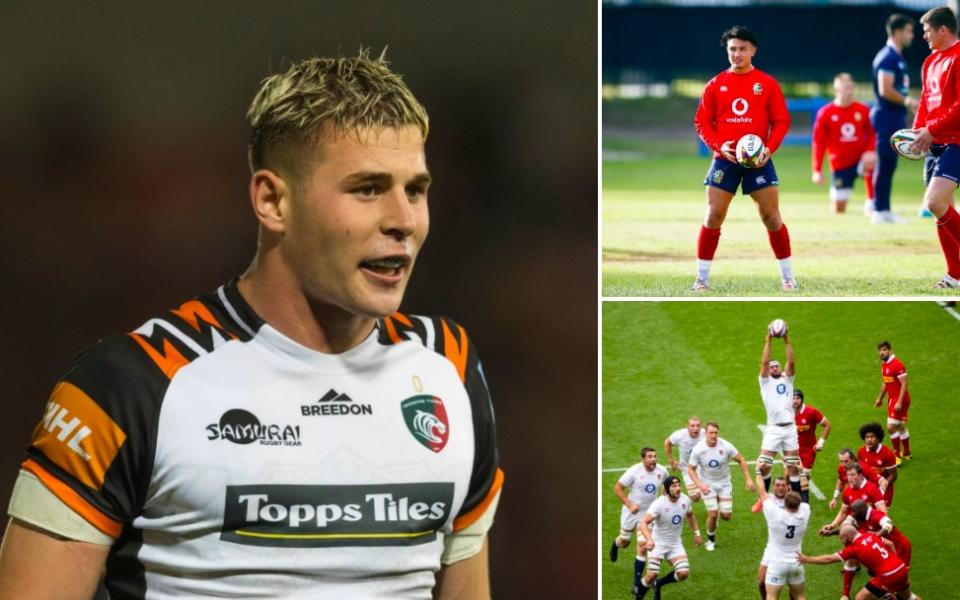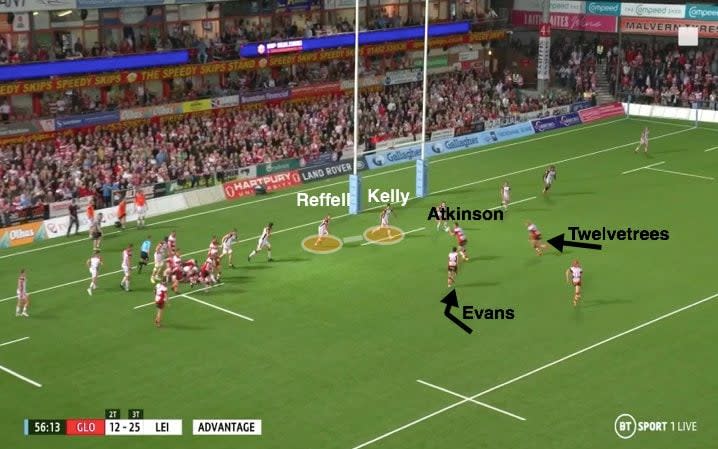Inside Line: England begin their search for World Cup combinations and wildcards

As ever, the announcement of an England squad sparked discussion. But whatever the qualms and controversies, there can be no denying that the 45-man group unveiled last week looks like an attempt to reinvigorate the spine of the team with two years until Rugby World Cup 2023.
A three-day get-together in Teddington between Sunday and Tuesday is to incorporate just a single training session, Eddie Jones explaining that the camp “will be more about administration”.
Whether or not you agree with how heavily Jones and the Rugby Football Union appear to focus on World Cups, this is an opportunity for some groundwork.
Front row: New faces for Cockerill and Proudfoot to mould
If England’s eagerness for another ball-carrying hooker was not obvious from how they fast-tracked Alfie Barbeary and approached Sale youngster Ewan Ashman – who politely rebuffed their advances and committed to Scotland – then the selection of Gabriel Oghre and Sam Riley has reinforced this desire.
The uncapped duo joins Jamie Blamire, he of four Test tries in two appearances, and Luke Cowan-Dickie in this group. It appears as though Jamie George, perhaps the first name on England’s team-sheet as recently as the 2020 Autumn Nations Cup, has been cast aside so that Eddie Jones can evaluate some potential front-row wildcards.
Remember how Jack Singleton covered back row and hooker at Rugby World Cup 2019? Well, Oghre started at openside flanker for Wasps against Bristol on Saturday. Although his throwing remains a work in progress, the 23-year-old is tenacious, mobile and comfortable on the ball. He made this bristling midfield carry at the weekend as part of a busy performance, which also featured a vital maul turnover in the 26th minute:
Even younger is Riley, who helped England to an Under-20 Grand Slam over the summer and made his Premiership debut for Harlequins at Kingston Park less than 48 hours before his maiden senior call-up.
He must be one of the roughest diamonds that Jones has mined to date, but proved himself as an exciting runner with a nose for the try-line at age-group level. Jones, Matt Proudfoot, Richard Cockerill and Martin Gleeson were all at the Twickenham Stoop to see Riley’s cameo against Worcester.
The subplots are similar when it comes to props. A high-profile Saracen, Mako Vunipola in this case, misses out and there is a clear emphasis on how a World Cup squad might materialise. Jones stressed the value of Trevor Davison’s rare ability to operate as a tighthead and a loosehead.
“That’s the beauty of him, he can play both,” Jones said of Davision, the one-cap Newcastle Falcon. “That gives him a lot of selection adaptability. In a World Cup squad, having a bloke who can play loosehead and tighthead is like absolute gold. He’s like Newcastle gold.”
England picked two tightheads in their 31 for Japan with a seemingly reluctant Joe Marler allocated as a deputy. He returns to the shake-up for this squad. Ellis Genge is the other senior loosehead with Beno Obano and Bevan Rodd scrapping below.
Rodd, a fine jackaller, was labelled as “probably the most promising” loosehead around by Jones and already looks excellent in the loose. Watch this try, finished by AJ MacGinty:
Well that was quick 😳
Your always in trouble when Tuilagi throws a step like that 😅
Lovely ball movement from @SaleSharksRugby for AJ MacGinty to finish the move 👏 #GallagherPrem pic.twitter.com/BCojbLhNnS— Rugby on BT Sport (@btsportrugby) September 26, 2021
It is Rodd who sparks the transition attack with a tumbling pass off the floor to MacGinty following Ben Curry’s turnover. These little touches earmark clever, skilful footballers:
As for specialist tightheads, Kyle Sinckler and Will Stuart are joined by the fast-improving Joe Heyes. George and Vunipola still have plenty to offer and could well feature as soon as the autumn.
You sense, though, that Cockerill and Proudfoot want to get their hands on some new blood. Given what happened against South Africa in Yokohama, as well as the marked set-piece improvements of Australia, scrummaging will be a priority.
Back row: How do you move on from Billy Vunipola?
Balance, balance, balance. This section is not just about the merits of Callum Chick, Alex Dombrandt and Sam Simmonds. The name of the game as Jones endeavours to reshape his back row is covering the subtler responsibilities that were previously take care of by Billy Vunipola.
As well as restart receipts, another major strength of Vunipola has been his distribution and strength at lineouts. Sure enough, Jones heralded the “incredible jumping skills” of Lewis Ludlow and suggested Gloucester’s captain could be “the best back-row jumper in England”.
Although he does not complete the steal, this defensive lineout against Leicester on Friday evening demonstrates Ludlow’s spring:
Tom Curry refined his lineout skills to join forces with Sam Underhill and Billy Vunipola, but it seems as though England want to help out their locks with a back-rower that is more comfortable as a jumping option. Think of what Justin Tipuric gives Wales. Curry will be an important passer from the scrum-half slot of shortened lineouts anyway, you would imagine.
As well as Ludlow and Courtney Lawes, you have the rangier pair of Ted Hill and George Martin. Uncapped Jack Kenningham and Lewis Ludlam are capable jumpers as well. The former plucks this throw from Jack Walker to initiate a rumbling, rolling maul nicely:
“We don’t know where this 50:22 law is going to go, whether it is going to be a big part of the game or a small part of the game,” Jones added.
“Most of the smart people in the world are thinking that lineouts are going to become even more important, [so] having a lineout jumper in the back row is going to be crucial.
“You need a six who can jump, you need your seven to be hard over the ball and you need your eight to do a bit of both: carry, get over the ball and be able to fill some gaps on the field.”
That positional breakdown is fluid. The point is that back-rowers complement one another. Toughness at the breakdown is one area in which Jones has seen improvements from Simmonds, who appeared to spend more time in the back-field and in wider channels as Exeter Chiefs attacked last season.
Dombrandt was given licence to roam, as he is with Harlequins, on his Test debut against Canada and Jones has assembled a mobile party of back-rowers that would, theoretically, thrive in an expansive gameplan. But lineout security is one non-negotiable that must be tended to first.
Midfield: What brings out the best in Marcus Smith?
The inclusion of 31-year-old Mark Atkinson raised eyebrows, and not because the Gloucester centre lacks quality. He has been consistent and effective for years, particularly as a foil for Danny Cipriani as Gloucester reached the Premiership play-offs in 2019.
More intriguing is the question of ‘why now?’ This was Jones’ reply to that very inquiry. Note that Marcus Smith is brought up unprompted:
“[Atkinson] has got a really good attitude and what I have been particularly impressed about is his communication skill,” Jones said.
“Twelves are the eyes and ears for 10s. If you look at the squad, at 12 we have got potentially Owen [Farrell] and Atkinson who are both very good communicators. If Marcus was to play at 10, you have got a good communicator with him at 12 and that is what most 10s want.”
Now, the rationale for Cipriani’s continued exclusion from training camps was that Jones wanted a small number of fly-halves so those playmakers could be more prominent and take more ‘reps’ on the field.
Such a policy probably makes more sense with a new attack coach, Gleeson, in place and Jones has been consistent. Smith and Owen Farrell are retained with George Ford overlooked despite his experience and domestic brilliance.
Jones’ comments hint at a backline underpinned by dual distributors – a Smith-Farrell axis or Atkinson dovetailing with either fly-half. During his stint with BT Sport on Friday evening, Dan Biggar revealed that Northampton had man-marked Atkinson with a back-rower as often as possible.
Leicester switched off momentarily on Friday, and paid the price:
Atkinson’s running threat is more potent because of his deft distribution. In this case, he slips between Tommy Reffell and Dan Kelly because of the distracting presence of teammates in motion around him – specifically Billy Twelvetrees cutting a hard angle and Lloyd Evans fading out the back:

At Harlequins, Smith is part of a beautifully balanced backline. First off, Danny Care’s influence and intuition takes pressure off him. Jones has picked three scurrying scrum-halves in Dan Robson, Harry Randall and Raffi Quirke to join Ben Youngs.
But the importance of hard-running André Esterhuizen to Harlequins – and, by association, to Smith – will not have been lost on Jones, either. That could prompt him to team up his erstwhile apprentice with Manu Tuilagi at inside centre and one of Henry Slade or Joe Marchant wearing 13. Smith and Ollie Lawrence share cohesion from the age-group pathway as well.
Either way, an imminent midfield revamp is another reason why this camp would be a good time to lay down captaincy contingencies. Should Smith grow into as much of a leader for England as he has become for Harlequins, there will be times – during matches or from the start – when England’s best backline does not contain Farrell.
Back three: Pace everywhere
Elliot Daly’s injury opens the door for Freddie Steward, who is personifying Leicester’s improvements, to establish himself. His courage and skill under the high ball was obvious from his first-team emergence.
Now, the 20-year-old is beginning to add bells and whistles as he becomes more prominent in attack. Here, as part of a 90-metre break-out, Steward passes to Nemani Nadolo before arcing around his hulking wing and picking up another touch to feed Matt Scott on the inside:
George Furbank, an emergency fly-half according to Jones, and Max Malins are two more full-backs in Teddington. Then the prospective wings are all rapid. Jonny May returns to the fold with Anthony Watson another Test half-centurion.
Adam Radwan, Ollie Sleightholme and Louis Lynagh boast a single cap between them. However, all of them are predatory finishers and Ruaridh McConnochie bolted from obscurity to the last World Cup. Radwan, a big hit of England’s summer, sliced through Bath at the weekend:
Versatility is a valuable trait and both Malins and Marchant have spent time on the wing, combining an ability to beat defenders with off-the-ball movement and distribution.
Malins is another potential stand-in fly-half as well, while Marchant was one of the stand-out performers in the Premiership decider last season.
As with all of these positional groups, there are players that could be whisked back in. Jack Nowell and Joe Cokanasiga spring to mind as tackle-breakers. Either way, Jones has plenty to work with, and plenty to work out, this week.

 Yahoo Sport
Yahoo Sport 





































